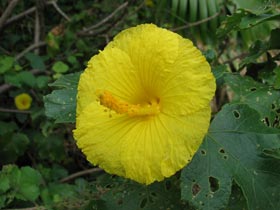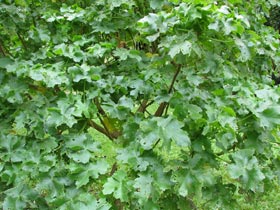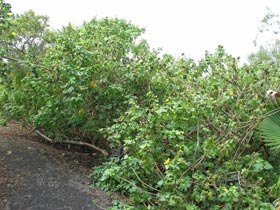Hibiscus brackenridgei subsp. brackenridgei
Genus
Hibiscus
Species
brackenridgei
Subspecies
- brackenridgei
Hawaiian Names with Diacritics
- Aloalo
- Maʻo hau hele
Hawaiian Names
- Aloalo
- Mao hau hele
Common Names
- Brackenridge's rosemallow
- Native yellow hibiscus
Distribution Status
Endemic
Endangered Species Status
Federally Listed
Plant Form / Growth Habit
- Sprawling Shrub
- Shrub
Mature Size, Height (in feet)
- Shrub, Small, 2 to 6
- Shrub, Medium, 6 to 10
- Shrub, Tall, Greater than 10
Mature Size, Width
Maʻo hau hele has an 8- to 10-foot spread.
Life Span
Long lived (Greater than 5 years)
Landscape Uses
- Container
- Hedges
- Screening
- Specimen Plant
Additional Landscape Use Information
Maʻo hau hele does very well in sunny areas such as south and west facing locations in the landscape. Over watering can cause powdery mildew on leaves and root rot. The sharp prickles around the base of the flowers can be a deterrent to picking the striking yellow flowers.
Source of Fragrance
- No Fragrance
Plant Produces Flowers
Yes
Flower Type
Showy
Flower Colors
- Yellow
Additional Flower Color Information
Maʻo hau hele produces bright yellow flowers with or without varying amounts of red or maroon centers in some varieties.
Blooming Period
- Spring
- Winter
Additional Blooming Period and Fruiting Information
Maʻo hau hele is typically a winter/spring flowering hibiscus.
Plant texture
- Medium
- Coarse
Additional Plant Texture Information
Leaves range from 2 to nearly 6 inches long.
Leaf Colors
- Medium Green
Additional Leaf Color Information
Leaves are grayish green and have a slightly rough texture. Some forms of this subspecies have glabrous (smooth) leaves such as some on Lānaʻi. [Robert Hobdy, Botanist]
Additional Pest & Disease Information
Mealy bugs can congregate in growing tips and deform the branch tips of maʻo hau hele. Ants and stress are the main causes for mealy bug infestations. Mealy bugs, white flies, spider mites and aphids are common pests. Root knot nematodes can be controlled organically by planting African marigolds in the area. Overwatering can cause powdery mildew on leaves and root rot. Chinese rose beetles can chew holes in the leaves.
Fertilizer
Maʻo hau hele has very little fertilizer requirements.
However, if you do fertilize maʻo hau hele use a 2-1-3 or 2-.5-3 ratio with minor elements. It is important to keep the phosphorus low because it tends to accumulate and prevents the nitrogen and potassium from working. Minor elements such as magnesium and iron are also important to maintain healthy green foliage. [1]
Pruning Information
Plants can be pruned back after flowering. Young plants should be pruned to encourage branching. Do not prune in winter and spring when it is flowering. Maʻo hau hele has a weak root system and can topple over if top heavy, pruning plant about 1/3 can prevent this.
Water Requirements
- Dry
Additional Water Information
Do not over water maʻo hau hele.
Soil must be well drained
Yes
Light Conditions
- Full sun
- Partial sun
Additional Lighting Information
Maʻo hau hele does best in full sun.
Tolerances
- Drought
- Heat
Soils
- Cinder
Limitations
Because of a shallow root system, maʻo hau hele is prone to toppling in strong winds.
Natural Range
- Molokaʻi
- Lānaʻi
- Maui
- Hawaiʻi
Natural Zones (Elevation in feet, Rainfall in inches)
- Less than 150, 0 to 50 (Dry)
- 150 to 1000, 0 to 50 (Dry)
- 1000 to 1999, 0 to 50 (Dry)
Additional Habitat Information
Rare and local in dry forest and shrubland. Maʻo hau hele was reportedly collected on Kahoʻolawe as well.
![]() Special Features and Information
Special Features and Information
General Information
The large Mallow family Malvaceae contains some 2,300 species, with notables such as okra, cacao, durian, baobab, kenaf, and cotton. [3]
There are perhaps as many as 300 species worldwide in the genus Hibiscus. There are six native species of hibiscuses in Hawaiʻi and all but one are endemic.
Maʻo hau hele (Hibiscus brackenridgei) has three subspecies. All are federally listed as endangered species.
Etymology
The generic name Hibiscus is derived from hibiscos, the Greek name for mallow.
The specific and subspecific epithet brackenridgei is named after William Dunlop Brackenridge (1810-1893), Scottish-American horticulturist and superintendent of the National Botanic Garden in Washington, D.C. [6]
Hawaiian Names:
Aloalo is the name given for hibiscus in general.
Hau is an introduced hibiscus (Hibiscus tiliaceus), perhaps by early Hawaiians. Hele means "traveling." Maʻo means green, but the yellow flowers turn green when drying. Thus, maʻo hau hele literally means "green traveling hau."
Background Information
The Story of Lānaʻi notes this with regard to the Lānaʻi maʻo hau hele: "Munro noticed three types that grew on Lānaʻi, including a tree form. Only two seedlings of a small, glabrous, unlobed leaf form barely survive at Kaʻena, Lānaʻi. The Keōmuku form is being monitored and looks secure for now. A population of plants were outplanted at Kānepuʻu. All the Lānaʻi plants are recognized as Hibiscus brackenridgei ssp. brackenridgei by David Bates in 1990." [7]
Early Hawaiian Use
Maʻo hau hele was planted for an ornamental use. [4]
Modern Use
When the hibiscus was named as the official flower for the Territory of Hawaiʻi by the Legislature in 1923, it was not specified as to any particular hibiscus species or variety. This lead to some confusion. In time many considered the Native red (Hibiscus kokio) or the Chinese red hibiscuses as the state flower. In 1988, however, Hawaii's State Legislature resolved the issue by declaring the Native yellow hibiscus or Maʻo hau hele (Hibiscus brackenridgei), as the official flower of the State of Hawaiʻi. [5]
Additional References
[1] Jill Coryell, Hibiscus Lady http://www.hibiscusladyhawaii.com/
[2] "Recovery Plant for the Multi-Island Plants" by USFWS, page 88.
[3] http://en.wikipedia.org/wiki/Malvaceae [Accessed 10/14/09]
[4] "Native Planters in Old Hawaii--Their Life, Lore, & Environment" by E. S. Handy and Elizabeth green Handy, page 233.
[5] Hawaiian Encyclopedia http://www.hawaiianencyclopedia.com/island-emblems.asp [Accessed 8/6/08]
[6] "Hibiscus: Hardy and Tropical Plants for the Garden" by Barbara Perry Lawton, page 105.
[7] "The Story of Lānaʻi" by George C. Munro, page 216.
PHOTOS FOR THIS SPECIES CAN BE SEEN AT THE LINK (Copy & Paste to your browser):
https://www.flickr.com/search/?user_id=50823119%40N08&sort=date-taken-desc&view_all=1&text=Hibiscus%20brackenridgei%20subsp.%20brackenridgei
Plant Gallery
Back to Plant List
Other Nursery Profiles for Hibiscus brackenridgei subsp. brackenridgei



